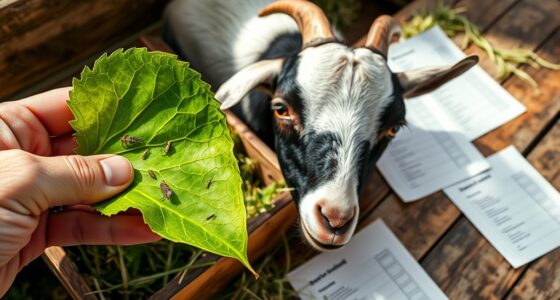To butcher and process your own chickens, start by ordering day-old chicks and providing a proper living space. Gather tools like a culling cone, sharp knives, and a scalding tank. Calmly place the chicken in the cone before making a neck cut to bleed it out. After bleeding, eviscerate carefully to avoid contamination. Chill the chicken for tenderness before packaging it for storage. There's much more to this process that can help you refine your technique.
Key Takeaways
- Sanitize all surfaces and tools before starting to ensure a clean butchering environment.
- Use a culling cone to humanely restrain the chicken before making the ventral neck cut.
- Allow the chicken to bleed out for at least three minutes for a painless death.
- Eviscerate carefully to avoid internal contamination, detaching intestines and other organs with precision.
- Chill the processed chicken in an ice chest for 6 to 24 hours to enhance tenderness before packaging.
Why We Raise Our Own Meat
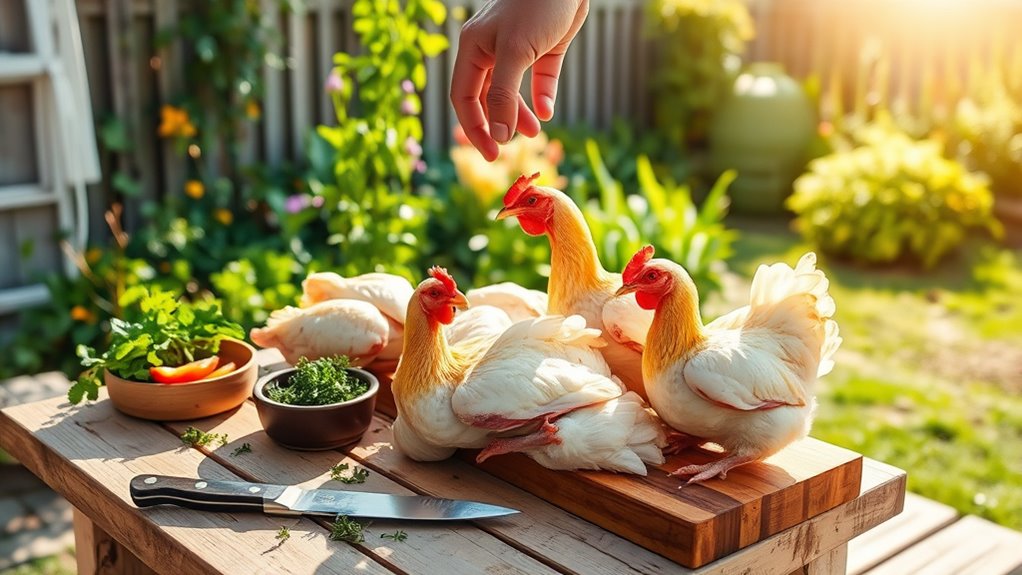
When you raise your own meat, you gain full control over the animal's life and treatment, which promotes a more ethical approach to consumption.
Raising chickens for meat allows you to guarantee they receive the best food and water, contributing to better health. This hands-on experience fosters a deeper understanding of the butchering process and the life cycle of animals, helping you appreciate where your food comes from.
Many who've shifted to homegrown meat report a change in mindset regarding meat consumption, often driven by concerns for sustainability and responsible sourcing.
How We Raise Our Chickens
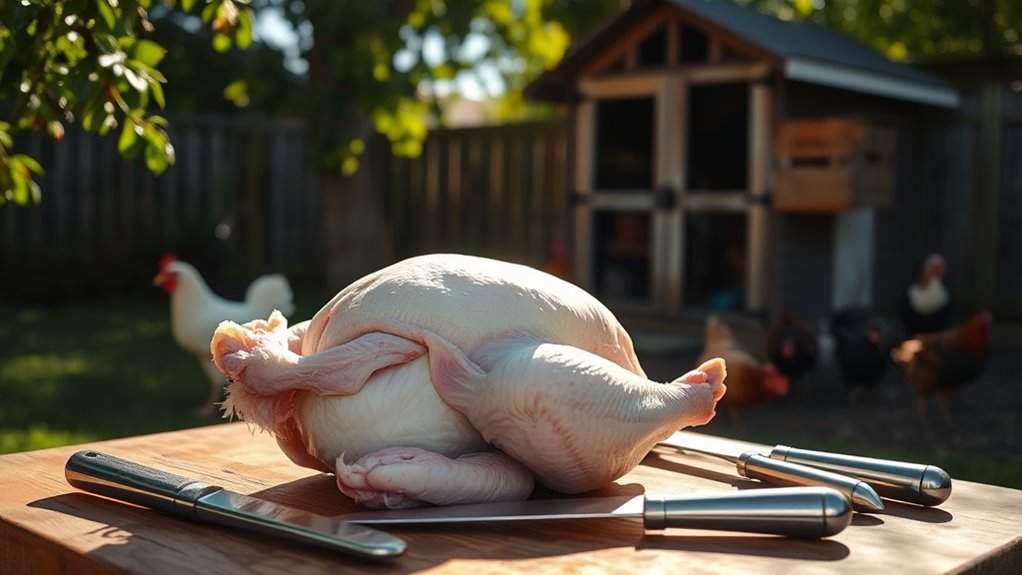
When you raise chickens, starting with the right chicks is essential.
We typically order 15 to 20 day-old Cornish Cross chicks from Hoovers Hatchery twice a year, ensuring they grow quickly and healthily.
Proper care practices, like providing ample space and nutrition, help them thrive and prepare for butcher day.
Chick Acquisition Process
Acquiring day-old chicks is a crucial step in raising your own chickens for meat. Order 15 to 20 Cornish Cross chicks from reputable hatcheries like Hoovers Hatchery, ideally twice a year.
This breed matures quickly, reaching 6 to 8 lbs in about six weeks, making them perfect meat chickens. Maintain a flock of 30 to 40 chickens until spring to guarantee a steady supply of meat.
Create a comfortable environment with a chicken coop or chicken tractor, providing at least 2 square feet per bird. Implement a feeding schedule of 12 hours on, 12 hours off to promote healthy growth.
Once they're ready, you'll be set to butcher a chicken and process a chicken at home for your needs.
Optimal Care Practices
To guarantee your chickens thrive, it's essential to provide ideal care practices right from the start.
Start by purchasing day-old Cornish Cross chicks from a reputable hatchery, ordering 15 to 20 at a time, twice a year. These birds are perfect for meat production, reaching 6 to 8 lbs in just six weeks.
Set up a traditional coop with ample space, ensuring each chicken has at least 2 square feet to reduce stress.
Implement a feeding schedule of 2 lbs of feed per chicken daily, with 12 hours of feeding followed by 12 hours without.
This optimal care will help you raise healthy chickens, ensuring you enjoy delicious meat and Farm Fresh Eggs while simplifying the butchering and processing later on.
Preparation and Tools for Butchering
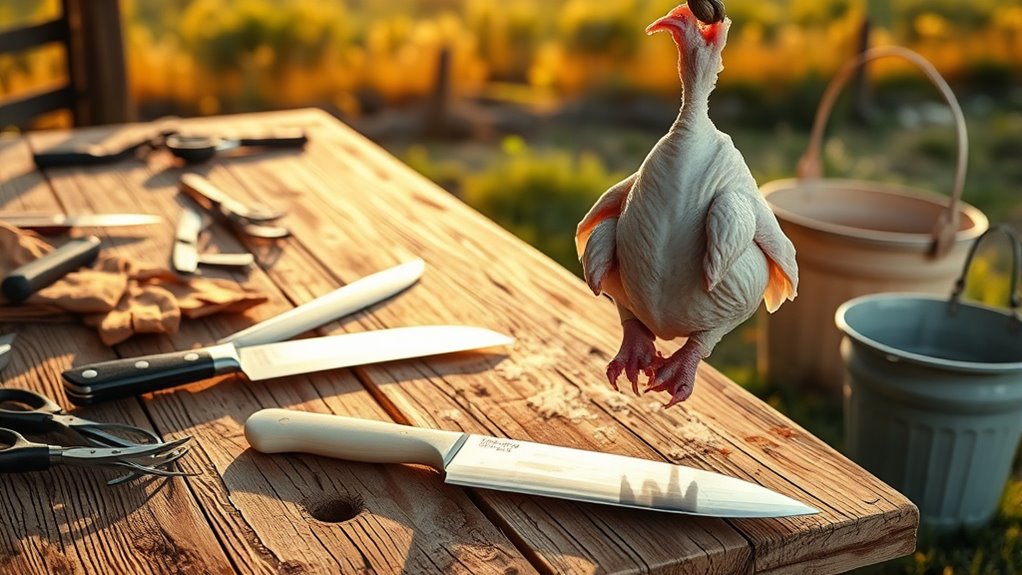
Before you start butchering, it's essential to prepare your workspace and gather the right tools.
Make certain to sanitize surfaces and equipment to guarantee a clean environment.
Having everything ready will help you work efficiently and maintain hygiene throughout the process.
Essential Butchering Tools
When butchering chickens, having the right tools is crucial for a smooth and humane process. Here's a quick guide to what you'll need:
| Tool | Purpose | Importance |
|---|---|---|
| Culling Cone | Guarantees humane slaughter | Animal welfare |
| Sharp Knives | For precise cuts during butchering | Efficiency |
| Stainless Steel Tables | Easy cleaning during processing | Hygiene |
| Scalding Tank | Loosens feathers for plucking | Fast feather removal |
| Chicken Plucker | Speeds up the feather removal | Time-saving |
You'll also need stainless steel tubs for waste management, a wash bucket for cleaning, and a thermometer to monitor the scalding water temperature. These tools make evisceration and processing safer and more effective.
Sanitization Practices
Maintaining a clean and sanitized workspace is essential for butchering chickens, as it greatly reduces the risk of contamination.
To achieve this, focus on the following:
- Sanitize tools and surfaces: Use bleach to disinfect stainless steel prep tables and other surfaces after each use.
- Clean as you go: Have a wash bucket or sink ready for immediate cleaning of tools during the butchering process.
- Utilize a culling cone: This tool prevents bruising during slaughter, ultimately enhancing meat quality.
Workspace Setup
A clean and organized workspace sets the stage for a successful butchering process. Designate a shaded area with electricity and running water, ensuring it's efficient for your workflow.
Use stainless steel prep tables, as they're easy to clean, and have a hose ready for rinsing. Gather essential processing equipment, including sharp knives, a meat cleaver for head removal, and a killing cone for humane slaughtering.
On butchering day, prepare a large pot or turkey fryer for scalding chickens at 140-150 degrees Fahrenheit to aid in feather removal. Additionally, ensure you have a waste collection system in place, as managing guts and feathers effectively is crucial for maintaining a clean workspace throughout the entire process.
Finally, set up a waste collection system with buckets or garbage bags to manage guts and feathers, keeping your workspace clean and organized throughout the entire process.
How to Slaughter Chickens
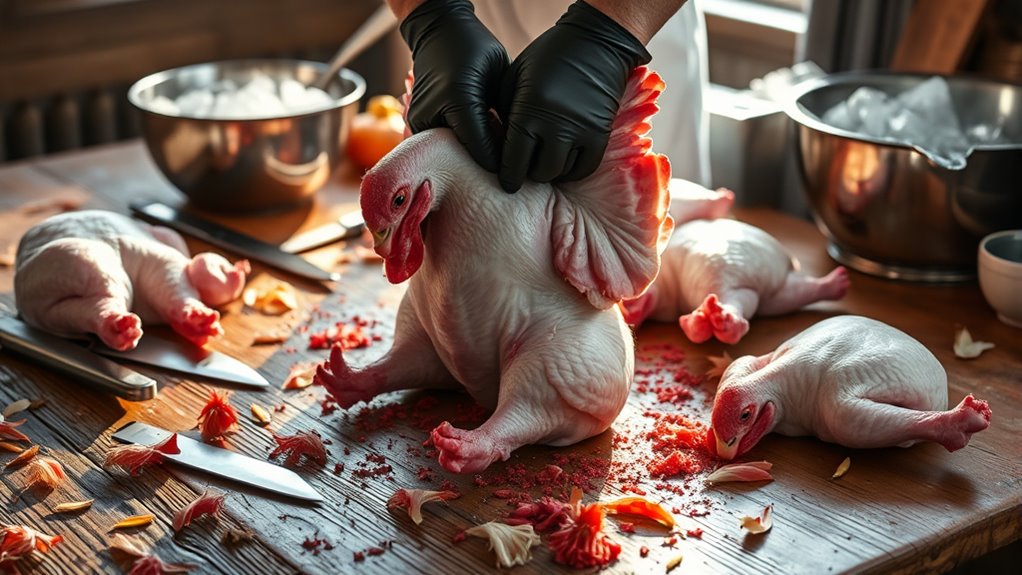
To guarantee a humane slaughter, start by placing the chicken in a culling cone, which helps prevent bruising and keeps it calm.
Before making the cut, disorient the chicken by gently swirling it to reduce stress.
Here's how to proceed:
- Make a ventral neck cut below the jawbone to sever the carotid arteries.
- Allow the chicken to bleed out for at least three minutes, ensuring a quick and painless death.
- Maintain a clean area with necessary tools, like a stainless steel bucket for blood collection and a cooler with ice for chilling the bird post-slaughter.
With everything organized and sanitized, you'll streamline the slaughtering process and prioritize the chicken's welfare.
Eviscerating the Chicken
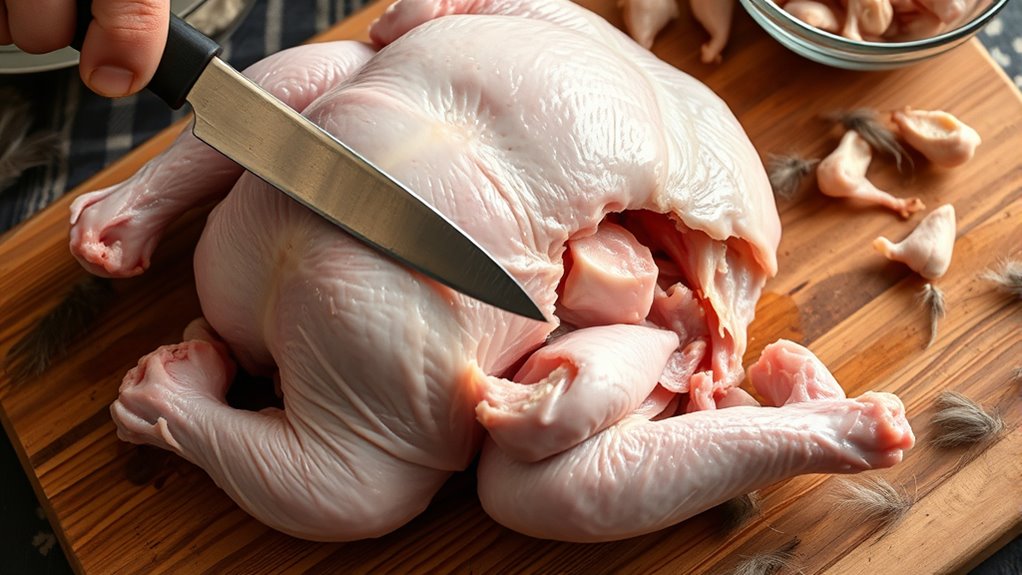
Eviscerating the chicken is a crucial step that requires precision and care.
Begin by carefully cutting the skin around the vent to avoid contamination of the internal organs. Use your fingers to gently separate the intestines, making sure you don't damage them and cause fecal contamination.
Next, cut away the tail by slicing through the vertebrae above the tail and oil gland to prevent off-flavors. Detach the trachea and crop by making small, precise cuts, avoiding any breach of the crop if it's full.
Throughout the evisceration process, maintain patience and cleanliness, as proficiency improves with experience. A hygienic approach guarantees that the meat remains safe and delicious for your future meals.
Storing the Chicken
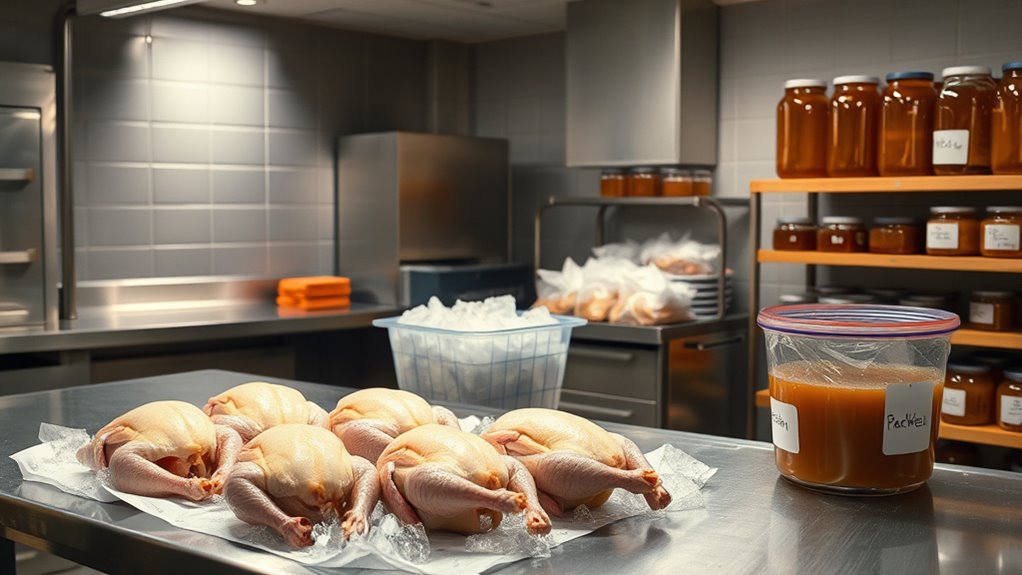
Once you've finished butchering the chicken, it's essential to store it properly to maintain its quality and safety. Here are three key steps to follow:
- Rest the Chicken: Place it in an ice chest for 6 to 24 hours. This resting period enhances tenderness and overall quality.
- Packaging: Use shrink bags or grocery produce bags for tight sealing. For best results, dip the chicken in water heated to 180°F for 5-10 seconds before sealing to create a vacuum effect, preventing freezer burn.
- Label and Store: Mark each package with the date and weight to track freshness. Store the chicken in the freezer at 0°F or lower, ensuring it stays safe and maintains its quality for long-term use.
Frequently Asked Questions
Can I Butcher My Own Chickens?
Yes, you can butcher your own chickens! It's a rewarding experience that connects you to your food.
Before starting, make certain you're properly prepared with the right equipment and a clean workspace. Withhold feed for about 12 hours to guarantee a cleaner process.
Using humane methods is essential for the chickens' welfare and the quality of the meat. There are plenty of resources available to guide you through the steps safely.
How to Slaughter a Chicken for Beginners?
Ever wondered how to do something as essential as slaughtering a chicken?
For beginners, start by preparing a calm area and securing the bird in a culling cone.
Make a swift, clean cut below the jaw to sever the carotid arteries, ensuring rapid bleeding.
Wait for three minutes to confirm it's bled out.
Always prioritize cleanliness and safety by sanitizing tools and surfaces before and after the process.
You've got this!
How Long After Butchering a Chicken Can You Eat It?
After butchering a chicken, you can eat it within 1-2 days if you store it properly in the refrigerator at 40°F (4°C) or lower.
For the best quality and taste, consider letting it rest in a cooler with ice for 6 to 24 hours.
If you freeze the chicken, it can last up to a year, but always check for off smells or discoloration before consuming to guarantee it's safe.
How Long Should Chickens Be off Feed Before Butchering?
When it comes to butchering chickens, you want to cross your T's and dot your I's.
Ideally, you should withhold feed for about 12 hours before processing. This practice helps guarantee their crops are empty, leading to cleaner meat and reducing the risk of contamination.
Just remember, keep their water accessible during this fasting period to keep them hydrated.
Planning this timing can make the process smoother for you and your flock.
Conclusion
To sum up, butchering your own birds can be a fulfilling and fantastic experience. With a bit of bravery and the right tools, you'll find that processing your chickens isn't just practical; it's profoundly rewarding. By embracing this hands-on approach, you deepen your connection to the food you eat, ensuring quality and care from coop to kitchen. So, gather your gear, get growing, and give it a go—you might just discover a newfound passion in poultry processing!






